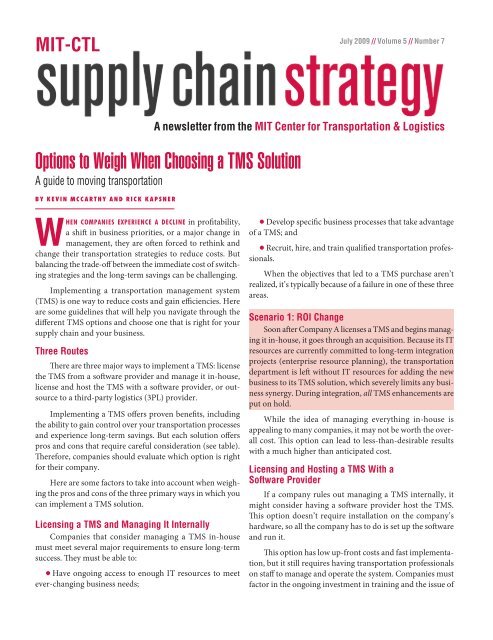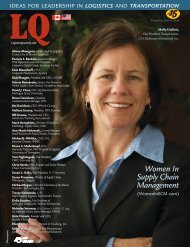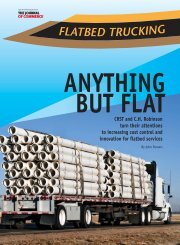Options to Weigh When Choosing a TMS Solution - CH Robinson
Options to Weigh When Choosing a TMS Solution - CH Robinson
Options to Weigh When Choosing a TMS Solution - CH Robinson
Create successful ePaper yourself
Turn your PDF publications into a flip-book with our unique Google optimized e-Paper software.
MIT-CTL<br />
WHEN COMPANIES EXPERIENCE A DECLINE in profi tability,<br />
a shift in business priorities, or a major change in<br />
management, they are oft en forced <strong>to</strong> rethink and<br />
change their transportation strategies <strong>to</strong> reduce costs. But<br />
balancing the trade-off between the immediate cost of switching<br />
strategies and the long-term savings can be challenging.<br />
Implementing a transportation management system<br />
(<strong>TMS</strong>) is one way <strong>to</strong> reduce costs and gain effi ciencies. Here<br />
are some guidelines that will help you navigate through the<br />
diff erent <strong>TMS</strong> options and choose one that is right for your<br />
supply chain and your business.<br />
Three Routes<br />
Th ere are three major ways <strong>to</strong> implement a <strong>TMS</strong>: license<br />
the <strong>TMS</strong> from a soft ware provider and manage it in-house,<br />
license and host the <strong>TMS</strong> with a soft ware provider, or outsource<br />
<strong>to</strong> a third-party logistics (3PL) provider.<br />
Implementing a <strong>TMS</strong> off ers proven benefi ts, including<br />
the ability <strong>to</strong> gain control over your transportation processes<br />
and experience long-term savings. But each solution off ers<br />
pros and cons that require careful consideration (see table).<br />
Th erefore, companies should evaluate which option is right<br />
for their company.<br />
Here are some fac<strong>to</strong>rs <strong>to</strong> take in<strong>to</strong> account when weighing<br />
the pros and cons of the three primary ways in which you<br />
can implement a <strong>TMS</strong> solution.<br />
Licensing a <strong>TMS</strong> and Managing It Internally<br />
Companies that consider managing a <strong>TMS</strong> in-house<br />
must meet several major requirements <strong>to</strong> ensure long-term<br />
success. Th ey must be able <strong>to</strong>:<br />
● Have ongoing access <strong>to</strong> enough IT resources <strong>to</strong> meet<br />
ever-changing business needs;<br />
July 2009 // Volume 5 // Number 7<br />
A newsletter from the MIT Center for Transportation & Logistics<br />
<strong>Options</strong> <strong>to</strong> <strong>Weigh</strong> <strong>When</strong> <strong>Choosing</strong> a <strong>TMS</strong> <strong>Solution</strong><br />
A guide <strong>to</strong> moving transportation<br />
BY KEVIN MCCARTHY AND RICK KAPSNER<br />
● Develop specifi c business processes that take advantage<br />
of a <strong>TMS</strong>; and<br />
● Recruit, hire, and train qualifi ed transportation professionals.<br />
<strong>When</strong> the objectives that led <strong>to</strong> a <strong>TMS</strong> purchase aren’t<br />
realized, it’s typically because of a failure in one of these three<br />
areas.<br />
Scenario 1: ROI Change<br />
Soon aft er Company A licenses a <strong>TMS</strong> and begins managing<br />
it in-house, it goes through an acquisition. Because its IT<br />
resources are currently committed <strong>to</strong> long-term integration<br />
projects (enterprise resource planning), the transportation<br />
department is left without IT resources for adding the new<br />
business <strong>to</strong> its <strong>TMS</strong> solution, which severely limits any business<br />
synergy. During integration, all <strong>TMS</strong> enhancements are<br />
put on hold.<br />
While the idea of managing everything in-house is<br />
appealing <strong>to</strong> many companies, it may not be worth the overall<br />
cost. Th is option can lead <strong>to</strong> less-than-desirable results<br />
with a much higher than anticipated cost.<br />
Licensing and Hosting a <strong>TMS</strong> With a<br />
Software Provider<br />
If a company rules out managing a <strong>TMS</strong> internally, it<br />
might consider having a soft ware provider host the <strong>TMS</strong>.<br />
Th is option doesn’t require installation on the company’s<br />
hardware, so all the company has <strong>to</strong> do is set up the soft ware<br />
and run it.<br />
Th is option has low up-front costs and fast implementation,<br />
but it still requires having transportation professionals<br />
on staff <strong>to</strong> manage and operate the system. Companies must<br />
fac<strong>to</strong>r in the ongoing investment in training and the issue of
Retuning Demand Forecast Muddled by Recession (continued)<br />
retaining the logistics department’s staff . Many companies<br />
have limited career paths for transportation professionals,<br />
and it is not uncommon for logistics employees with soft -<br />
ware training <strong>to</strong> take jobs at other companies <strong>to</strong> further their<br />
careers. <strong>When</strong> licensing a <strong>TMS</strong>, the company will generally<br />
also have <strong>to</strong> pay continual ongoing maintenance and support<br />
fees related <strong>to</strong> the <strong>TMS</strong>, which can vary annually from 18<br />
percent <strong>to</strong> 25 percent of the <strong>to</strong>tal license costs.<br />
Scenario 2: High Turnover<br />
Aft er determining that managing a <strong>TMS</strong> internally is<br />
beyond its scope, Company B decides <strong>to</strong> use a soft ware vendor<br />
<strong>to</strong> host its <strong>TMS</strong>. Initially, this decision works out well,<br />
but over time, the company’s trained staff leave <strong>to</strong> pursue<br />
opportunities with larger companies that off er higher pay<br />
for their expertise. Company B ends up incurring additional,<br />
unexpected training and recruiting costs that eat away at<br />
its long-term savings, and, more importantly, uses its <strong>TMS</strong><br />
sub-optimally.<br />
Before deciding <strong>to</strong> have a soft ware provider host your<br />
<strong>TMS</strong>, consider how you will retain your trained staff and<br />
avoid the turnover that will lead <strong>to</strong> a loss of valuable employees<br />
and an increase in recruiting and training costs. If a company<br />
is unable <strong>to</strong> retain trained staff , it may experience the<br />
<strong>TMS</strong> PROS AND CONS<br />
<strong>TMS</strong> Option<br />
License the <strong>TMS</strong><br />
and manage internally<br />
License and host the <strong>TMS</strong> with a<br />
software provider<br />
same type of imbalance between costs and savings as if it had<br />
managed the <strong>TMS</strong> internally.<br />
<strong>Choosing</strong> <strong>to</strong> Outsource <strong>to</strong> a 3PL<br />
Since there are many outsourced <strong>TMS</strong> models available,<br />
companies should fully investigate all options that prospective<br />
3PLs off er and choose the one that best aligns with their<br />
business. Th e most popular 3PL solutions are (1) the single<br />
source and (2) the lead logistics (4PL) model. Since there is<br />
more than one model, your fi rst consideration is <strong>to</strong> determine<br />
which one is right for your business.<br />
For companies with smaller transportation spends<br />
or less head count, a single source may off er the greatest<br />
potential value. Th e single-source solution combines all the<br />
benefi ts of the <strong>TMS</strong> and established carrier relationships.<br />
Th is model can solve capacity challenges. Th e 3PLs are also<br />
likely <strong>to</strong> provide the cus<strong>to</strong>mer with lower freight rates due<br />
<strong>to</strong> their broad access <strong>to</strong> capacity and purchasing power. An<br />
additional benefi t is that the cus<strong>to</strong>mer negotiates all the rates<br />
with one 3PL provider rather than with many carriers.<br />
It is important <strong>to</strong> consider a complicating fac<strong>to</strong>r in the<br />
single-source model: 3PLs make a margin on the diff erence<br />
between what they charge <strong>to</strong> their cus<strong>to</strong>mer and their cost<br />
Pros Cons<br />
● Use own IT staff <strong>to</strong> implement and ● High up-front costs<br />
maintain the software<br />
● Longer, more complex, and<br />
● Low ongoing licensing fees<br />
expensive implementation<br />
● Requires trained staff <strong>to</strong> learn,<br />
manage, operate, and maintain the<br />
software<br />
● Mid- <strong>to</strong> long-term software<br />
maintenance costs<br />
● Ongoing IT dependency<br />
● Low up-front costs<br />
● Minimal IT dependency<br />
● Short implementation<br />
Outsource <strong>to</strong> a 3PL ● Low up-front costs<br />
● Minimal IT dependency<br />
● Short implementation<br />
● Includes professional <strong>TMS</strong><br />
operations staff<br />
● Ongoing leasing costs<br />
● Requires trained staff <strong>to</strong> learn,<br />
manage, and operate the software<br />
● Need <strong>to</strong> interface existing order<br />
system with the <strong>TMS</strong><br />
● Ongoing outsource costs<br />
● Need <strong>to</strong> interface existing order<br />
system with the <strong>TMS</strong><br />
2 | supply chain strategy www.ioma.com/supply_chain
of hiring capacity. If the 3PL is not incentivized and measured<br />
on service results, the cus<strong>to</strong>mer may not receive an<br />
optimal solution, the business relationship might fail, or the<br />
cus<strong>to</strong>mer may change 3PLs. Th is problem can be avoided by<br />
setting clear pricing and service objectives up front. Using<br />
external benchmarks is a best practice in this model.<br />
Scenario 3: Single Source 3PL Hopping<br />
Company C chooses <strong>to</strong> single source with a 3PL and<br />
saves a signifi cant amount of money. Over the next three<br />
years, there are periodic rate increases. Eventually, the company<br />
shops the market and fi nds a provider who can do the<br />
work for less. But moving from 3PL <strong>to</strong> 3PL in search of the<br />
lowest bidder causes Company C <strong>to</strong> once again incur the<br />
costs of running the request for proposal, implementing new<br />
<strong>TMS</strong> solutions, and retraining, which signifi cantly cuts in<strong>to</strong><br />
any potential savings.<br />
With the lead logistics model, alignment of goals is less<br />
of an issue. Th e company receives full visibility <strong>to</strong> underlying<br />
rates, and the 3PL provides dashboards and reporting <strong>to</strong> help<br />
meet its strategic goals. Th e company sends orders <strong>to</strong> the 3PL<br />
in exchange for tracking, tracing, and payment information.<br />
In this model, costs can be fee-based (pay-as-you-go), so as<br />
your business changes, your costs go up or down (respectively)<br />
in tandem.<br />
The 3PL also provides the professional operations<br />
staff <strong>to</strong> run and update the soft ware for you. Th is minimizes<br />
the issue of staff turnover, since 3PLs are typically<br />
larger organizations that have the resources and career<br />
paths necessary <strong>to</strong> hire and retain seasoned transportation<br />
professionals.<br />
Oft en, because the 3PL employs trained <strong>TMS</strong> professionals,<br />
it’s possible that fewer resources will be required for<br />
operations than if the company hired staff on its own.<br />
Th e staff comes at a cost, since the 3PL will charge a fee<br />
for providing staff <strong>to</strong> run the <strong>TMS</strong>.<br />
Regardless of which outsourcing model you choose,<br />
remember that most of the knowledge and expertise<br />
about your transportation will be housed outside of your<br />
organization. While many companies view this as a negative,<br />
outsourcing the day-<strong>to</strong>-day operations <strong>to</strong> the 3PL<br />
allows a company <strong>to</strong> pursue more strategic issues, such<br />
as improving carrier performance or changing processes<br />
<strong>to</strong> increase on-time deliveries. If executed correctly and<br />
over the long term, outsourcing a <strong>TMS</strong> with a 3PL can<br />
be a successful model for companies <strong>to</strong> save money with<br />
limited investment.<br />
Final Considerations<br />
With all the <strong>TMS</strong> options available, companies should<br />
consider each option carefully <strong>to</strong> determine which will strike<br />
the optimal balance between cost and savings. It is imperative<br />
that you determine a direction before creating an RFP.<br />
If you choose <strong>to</strong> license a <strong>TMS</strong>, your RFP should focus on<br />
the specifi c types of soft ware features you need <strong>to</strong> implement<br />
your <strong>TMS</strong>. If you choose <strong>to</strong> outsource, the RFP should<br />
emphasize the kind of dedicated people and resources your<br />
business needs for a successful outsource relationship. Th e<br />
focus is simply diff erent.<br />
Supply Chain Strategy is a monthly newsletter produced by the MIT Center for Transportation & Logistics and published by IOMA. This article<br />
was originally published in the July 2009 issue of Supply Chain Strategy and is republished here with the express written permission of IOMA.<br />
© 2009. It is a violation of federal copyright law <strong>to</strong> reproduce all or part of this publication or its contents by any means. The Copyright Act<br />
imposes liability of up <strong>to</strong> $150,000 per issue for such infringement. Information concerning illicit duplication will be gratefully received. To<br />
ensure compliance with all copyright regulations or <strong>to</strong> acquire a license for multi-subscriber distribution within a company or for permission<br />
<strong>to</strong> republish, please contact Jonathan Wentworth-Ping at IOMA’s corporate licensing department, 973-718-4703, or e-mail jping@ioma.<br />
com. For more information about IOMA or <strong>to</strong> subscribe <strong>to</strong> any IOMA publication, go <strong>to</strong> www.ioma.com.<br />
[Key Takeaways]<br />
» One way <strong>to</strong> reduce costs and increase supply chain effi<br />
ciency is <strong>to</strong> change the way you manage transportation by<br />
adopting a transportation management system (<strong>TMS</strong>).<br />
» There are three main routes <strong>to</strong> a <strong>TMS</strong> and each one requires<br />
careful thought if you want <strong>to</strong> arrive at a solution that not<br />
only meets your immediate cost and effi ciency targets but is<br />
also aligned with your business strategy.<br />
Before making a decision, companies should ask the allencompassing<br />
question: Do we want <strong>to</strong> save money on our<br />
budget or on the results? Taking this question in<strong>to</strong> consideration<br />
will help you make the right decision for your business<br />
and avoid the costly mistake of sacrifi cing long-term savings<br />
for what looks like the cheapest option. ◆<br />
Kevin McCarthy is a direc<strong>to</strong>r of logistics solutions at C.H. <strong>Robinson</strong><br />
Worldwide Inc., one of the largest third-party logistics companies<br />
in the world. He can be contacted at kevin.mccarthy@chrobinson<br />
.com. Rick Kapsner is a direc<strong>to</strong>r of corporate sales at C.H. <strong>Robinson</strong><br />
Worldwide Inc. and can be contacted at rick.kapsner@chrobinson<br />
.com.<br />
July 2009 | 3




